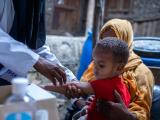Mar 25, 2009 (CIDRAP News) – A program to help the nation's largest metropolitan area deliver medications after a public health emergency such as an aerosol anthrax attack has improved their readiness levels, according to initial findings released yesterday by the Rand Corp.
The Cities Readiness Initiative (CRI), administered by the Centers for Disease Control and Prevention (CDC), was launched in 2004 to help cities distribute antibiotics and other medications to 100% of the local population within 48 hours of a bioterror attack or other widespread infectious disease outbreak. The program covers 72 metropolitan are, about 57% of the nation's population, at a cost of $300 million so far, the Rand Corp. said in a press release yesterday.
In 2007, the CDC asked Rand to conduct an initial evaluation to determine cities' progress on the basis empirical evidence, a CDC assessment of 12 core functional areas, and discussions with countermeasure-dispensing personnel in nine metropolitan areas. The 118-page report appears on Rand's Web site.
The evaluators from Rand reported the CRI has improved regions' readiness by allowing them to:
- Increase the number of staff working on countermeasure dispensing
- Strengthen partnerships with other responders who play key roles in dispensing, such as law enforcement and emergency management
- Adopt streamlined dispensing methods that incorporate nonmedical staff and use nontraditional sites such as schools, businesses, and bank drive-throughs
- Purchase equipment and supplies such as mobile dispensing units and communications equipment
- Conduct planning activities such as security assessments, training, and exercises
"One public health official summed up the situation by stating that these changes resulted in 'creating' preparedness where it had not previously existed," the authors reported.
The program's focus on a single scenario—an aerosol anthrax attack—along with specific targets has helped recipients prioritize their resources and reach out to vital partners, the authors reported. However, they found that areas with decentralized public health systems had a harder time forging relationships with other first responders, often because of the sheer number of jurisdictions.
Some topics were difficult to assess, such as CRI's spillover effect on other public health functions and other cities and regions that aren't participating in the program, the report said. Also, the evaluators reported that though exercise performance yields some useful data, they lacked appropriate performance standards to assess operational ability.
The CRI is worth continuing, authors concluded. They recommended that the CDC reassess the program again in 2 to 3 years, continue developing measurement systems, and keep making improvements in technical assistance and assessment.
Aside from evaluating the impact of the CRI, the Rand group recommended that the CDC also consider if the program's achievements are worth the cost. "Future evaluations could be extended to include assessments of public health risks, risk reduction, and the cost-effectiveness of public health programs," they wrote.
See also:
Mar 24 Rand Corporation press release
Mar 24 Rand Corporation initial Cities Readiness Initiative evaluation



















